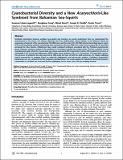Por favor, use este identificador para citar o enlazar a este item:
http://hdl.handle.net/10261/40933COMPARTIR / EXPORTAR:
 SHARE SHARE
 CORE
BASE CORE
BASE
|
|
| Visualizar otros formatos: MARC | Dublin Core | RDF | ORE | MODS | METS | DIDL | DATACITE | |

| Campo DC | Valor | Lengua/Idioma |
|---|---|---|
| dc.contributor.author | López-Legentil, S. | - |
| dc.contributor.author | Song, Bongkeun | - |
| dc.contributor.author | Bosch, Manel | - |
| dc.contributor.author | Pawlik, Joseph R. | - |
| dc.contributor.author | Turon, Xavier | - |
| dc.date.accessioned | 2011-10-11T09:15:17Z | - |
| dc.date.available | 2011-10-11T09:15:17Z | - |
| dc.date.issued | 2011 | - |
| dc.identifier.citation | PLoS ONE 6(8) : e23938 | es_ES |
| dc.identifier.issn | 1932-6203 | - |
| dc.identifier.uri | http://hdl.handle.net/10261/40933 | - |
| dc.description | 12 páginas, 6 fguras, 1 tabla. | es_ES |
| dc.description.abstract | Symbiotic interactions between ascidians (sea-squirts) and microbes are poorly understood. Here we characterized the cyanobacteria in the tissues of 8 distinct didemnid taxa from shallow-water marine habitats in the Bahamas Islands by sequencing a fragment of the cyanobacterial 16S rRNA gene and the entire 16S–23S rRNA internal transcribed spacer region (ITS) and by examining symbiont morphology with transmission electron (TEM) and confocal microscopy (CM). As described previously for other species, Trididemnum spp. mostly contained symbionts associated with the Prochloron-Synechocystis group. However, sequence analysis of the symbionts in Lissoclinum revealed two unique clades. The first contained a novel cyanobacterial clade, while the second clade was closely associated with Acaryochloris marina. CM revealed the presence of chlorophyll d (chl d) and phycobiliproteins (PBPs) within these symbiont cells, as is characteristic of Acaryochloris species. The presence of symbionts was also observed by TEM inside the tunic of both the adult and larvae of L. fragile, indicating vertical transmission to progeny. Based on molecular phylogenetic and microscopic analyses, Candidatus Acaryochloris bahamiensis nov. sp. is proposed for this symbiotic cyanobacterium. Our results support the hypothesis that photosymbiont communities in ascidians are structured by host phylogeny, but in some cases, also by sampling location. | es_ES |
| dc.language.iso | eng | es_ES |
| dc.publisher | Public Library of Science | es_ES |
| dc.relation.isversionof | Publisher's version | - |
| dc.rights | openAccess | es_ES |
| dc.title | Cyanobacterial Diversity and a New Acaryochloris-Like Symbiont from Bahamian Sea-Squirts | es_ES |
| dc.type | artículo | es_ES |
| dc.identifier.doi | 10.1371/journal.pone.0023938 | - |
| dc.description.peerreviewed | Peer reviewed | es_ES |
| dc.relation.publisherversion | http://dx.doi.org/10.1371/journal.pone.0023938 | es_ES |
| dc.identifier.pmid | 21915246 | - |
| dc.type.coar | http://purl.org/coar/resource_type/c_6501 | es_ES |
| item.cerifentitytype | Publications | - |
| item.grantfulltext | open | - |
| item.openairecristype | http://purl.org/coar/resource_type/c_18cf | - |
| item.fulltext | With Fulltext | - |
| item.languageiso639-1 | en | - |
| item.openairetype | artículo | - |
| Aparece en las colecciones: | (CEAB) Artículos | |
Ficheros en este ítem:
| Fichero | Descripción | Tamaño | Formato | |
|---|---|---|---|---|
| Lopez-Legentil et al 2011 PLoS One.pdf | 5,14 MB | Adobe PDF |  Visualizar/Abrir |
CORE Recommender
PubMed Central
Citations
18
checked on 15-abr-2024
SCOPUSTM
Citations
50
checked on 23-abr-2024
WEB OF SCIENCETM
Citations
42
checked on 27-feb-2024
Page view(s)
349
checked on 24-abr-2024
Download(s)
216
checked on 24-abr-2024
Google ScholarTM
Check
Altmetric
Altmetric
Artículos relacionados:
NOTA: Los ítems de Digital.CSIC están protegidos por copyright, con todos los derechos reservados, a menos que se indique lo contrario.
